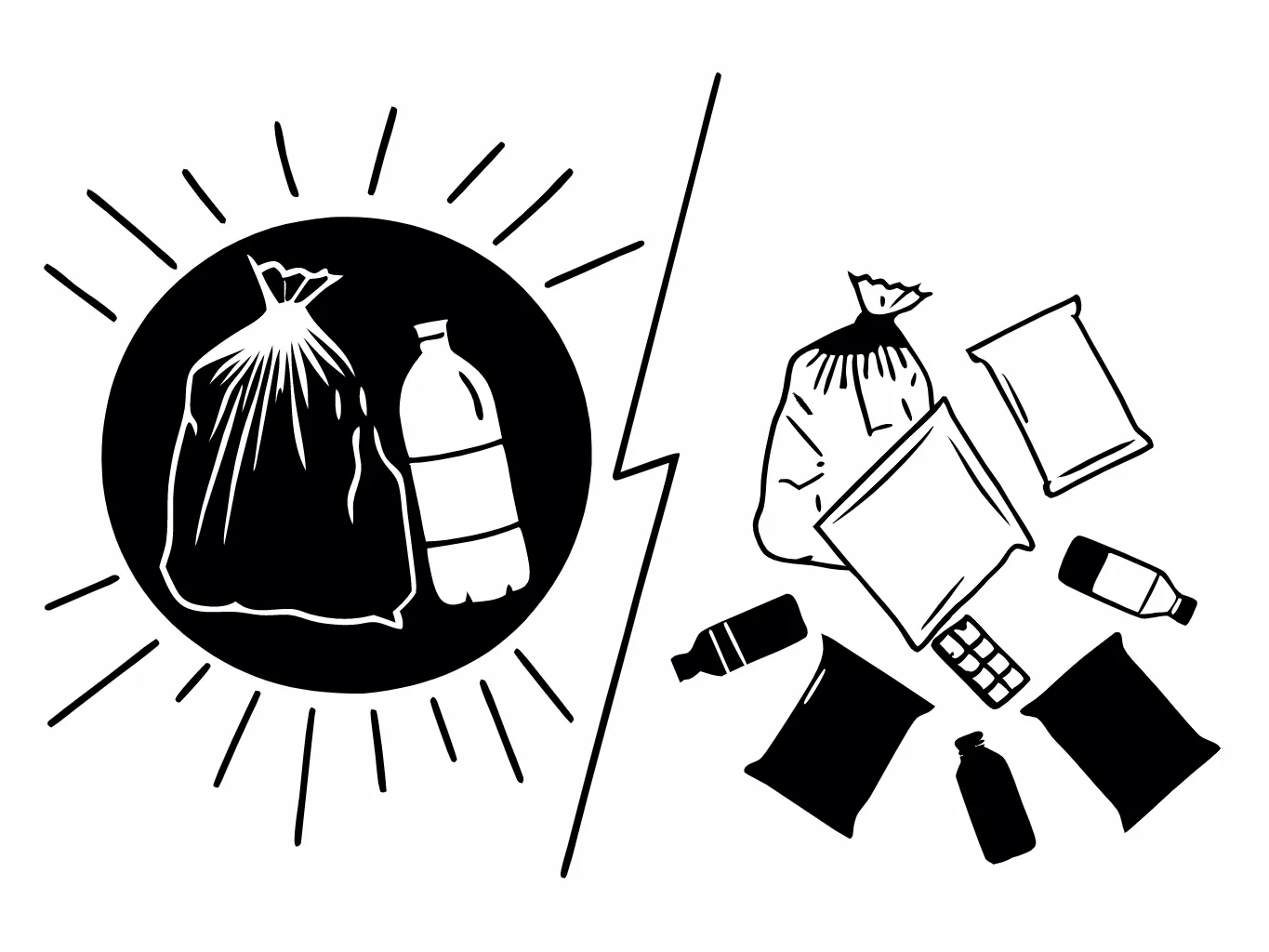Recikliranje plastike vitalni je aspekt upravljanja otpadom i promicanja održivosti. Međutim, ne reciklira se sva plastika na isti način. Dvije glavne kategorije—kruta i savitljiva plastika—razlikuju se po metodama obrade i krajnjoj upotrebi. U ovom ćemo vodiču usporediti tehnologije recikliranja za obje vrste, pružajući uvid u njihove jedinstvene izazove i budućnost recikliranja plastike.
Materijalne razlike i identifikacija
Kruta plastika
Čvrsta plastika zadržava svoj oblik nakon obrade i često se nalazi u svakodnevnim predmetima poput boca, posuda i igračaka. Obično se izrađuju od materijala kao što su Polietilen visoke gustoće (HDPE), polipropilen (PP), i Polietilen tereftalat (PET). Ovu plastiku lako je identificirati pomoću Identifikacijski kod smole (RIC), obično prikazan kao broj unutar trokuta sa strelicama. Za detaljniju identifikaciju, možete istražiti naš vodič za razumijevanje kodova plastične smole.
Fleksibilna plastika
Za razliku od krute plastike, fleksibilna plastika može se savijati i oblikovati u različite oblike. Uobičajeni primjeri uključuju plastične vrećice, filmova, i vrećice, obično napravljen od Polietilen niske gustoće (LDPE) i Linearni polietilen niske gustoće (LLDPE). Iako također koriste RIC, prepoznavanje savitljive plastike može biti teže zbog njihove tanke, lagane prirode i poteškoća s čitanjem malih ispisa.
Tehnologije obrade
Recikliranje čvrste plastike
1. Sortiranje: Optički uređaji za sortiranje i ručni rad koriste se za odvajanje krute plastike na temelju njihove boje i vrste smole.
2. Pranje: Proces recikliranja uključuje pranje kako bi se uklonili kontaminanti, poput ostataka hrane i naljepnica, čime se osigurava čistoća materijala prije daljnje obrade.
3. Mljevenje: Nakon pranja plastika se melje u manje komade kako bi se njome lakše rukovalo.
4. Ekstruzija/Peletiranje: Male plastične čestice se tope i preoblikuju u kuglice, koje se zatim mogu ponovno upotrijebiti u proizvodnji novih proizvoda. Čvrsta plastika često se reciklira u proizvode poput plastično drvo, spremnici, i automobilski dijelovi.
Fleksibilno recikliranje plastike
1. Prikupljanje i prethodno sortiranje: Fleksibilna plastika predstavlja izazov u prikupljanju zbog svoje lagane prirode i sklonosti zapetljavanju. Poboljšanje ovih metoda prikupljanja ključno je područje istraživanja koje je u tijeku.
2. Pranje i sušenje: Za fleksibilnu plastiku ključno je učinkovito ukloniti onečišćenja. Folije i vrećice zahtijevaju temeljit proces pranja kako bi se osiguralo da su dovoljno čisti za recikliranje.
3. Aglomeracija: Tijekom ove faze, fleksibilna plastika se topi i stapa u veće nakupine, što olakšava rukovanje i obradu.
4. Smjesa/ponovna obrada: Aglomerirani materijal se zatim prerađuje u pelete ili pahuljice, koje se mogu ponovno upotrijebiti u proizvodnji novih filmova, pakiranja ili čak kompozitno drvo. Za rukovanje ovim laganim, tankim materijalima često je potrebna posebna oprema.
Primjene krajnjeg proizvoda
Reciklirana kruta plastika
Reciklirana kruta plastika često se ponovno koristi u proizvodnji nove boce, spremnici, namještaj, cijevi, i automobilski dijelovi. Zbog svoje čvršće prirode, kruta plastika često se podvrgava zatvorena petlja recikliranja, gdje se materijal reciklira u istu vrstu proizvoda, osiguravajući ponovnu upotrebu visoke kvalitete.
Reciklirana fleksibilna plastika
Fleksibilna plastika, s druge strane, obično se pretvara u novi filmovi, torbe, i pakiranje. Osim toga, mogu se koristiti za proizvodnju kompozitno drvo. Međutim, kvaliteta reciklirane fleksibilne plastike može patiti od kontaminacijai degradacija, posebno kada se radi o primjeni u prehrambenoj industriji. Postizanje visokokvalitetne reciklirane fleksibilne plastike ostaje veliki izazov u industriji.
Izazovi i budući trendovi
Recikliranje krute i fleksibilne plastike suočava se s nekoliko ključnih izazova:
1. Kontaminacija: Zagađivači, poput ostataka hrane i naljepnica, mogu smanjiti kvalitetu recikliranih materijala i zakomplicirati proces recikliranja.
2. Složenost sortiranja: Učinkovito sortiranje različitih vrsta plastike zahtijeva napredne tehnologije. Trenutačni sustavi sortiranja često imaju problema s razlikovanjem sličnih vrsta plastike, osobito kada je riječ o fleksibilnoj plastici.
3. Potražnja krajnjeg tržišta: Kako bi proces recikliranja bio održiv, mora postojati snažno tržište za recikliranu plastiku. Inovacije u kemijsko recikliranje pojavljuju se kao obećavajuće rješenje za neke od ovih izazova, omogućujući razgradnju plastike na izvorne komponente za ponovnu upotrebu.
Zaključak
Razumijevanje razlika između recikliranja krute i fleksibilne plastike ključno je za poboljšanje gospodarenja otpadom i održivosti. Rješavanjem jedinstvenih izazova koje predstavlja svaka vrsta plastike i ulaganjem u nove tehnologije, možemo pokrenuti budućnost recikliranja plastike. Kako potražnja za recikliranim materijalima raste, industrija je spremna vidjeti značajan napredak koji će pomoći zatvoriti krug i smanjiti utjecaj plastičnog otpada na okoliš.
FAQ
1. Koja je razlika između krute i savitljive plastike?
Kruta plastika zadržava svoj oblik nakon obrade, poput boca i spremnika, dok se fleksibilna plastika može savijati i oblikovati u različite oblike, poput filmova i vrećica.
2. Kako se kruta plastika reciklira?
Čvrsta plastika se sortira, pere, melje u manje komade, a potom topi i pretvara u kuglice koje se mogu koristiti za stvaranje novih proizvoda.
3. Može li se savitljiva plastika reciklirati na isti način kao i kruta plastika?
Ne, fleksibilna plastika zahtijeva različite tehnike obrade, uključujući aglomeraciju i specijaliziranu opremu, zbog svoje male težine i često teške za rukovanje.
4. Koji su izazovi recikliranja savitljive plastike?
Fleksibilna plastika suočava se s izazovima kao što su kontaminacija, teško razvrstavanje i degradacija kvalitete, osobito kada se koristi u prehrambenim aplikacijama.
5. Zašto postoji potreba za naprednim tehnologijama sortiranja?
Potrebne su učinkovite tehnologije razvrstavanja kako bi se razlikovale različite vrste plastike, poboljšavajući učinkovitost procesa recikliranja i smanjujući kontaminaciju.
6. Što je kemijsko recikliranje i kako ono može pomoći u recikliranju plastike?
Kemijsko recikliranje razgrađuje plastiku na njezine osnovne komponente, omogućujući bolju ponovnu upotrebu i rješavajući neke od izazova u recikliranju krute i savitljive plastike.



